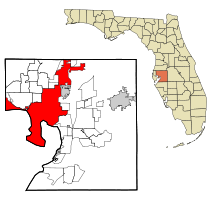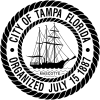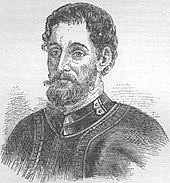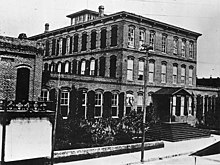a place to share random thoughts in nature
Wednesday, July 15, 2015
friendly fire by bryan
describes an Iowa farm family, Gene and Peg Mullen, and their reaction
and change of heart after their son's accidental death by friendly fire
in the Vietnam War
Wednesday, July 1, 2015
Tampa, Florida
"Tampa" redirects here. For other uses, see Tampa (disambiguation).
| Tampa, Florida | |||
|---|---|---|---|
| City | |||
| City of Tampa | |||

Images from top, left to right: Skyline of Downtown Tampa, Amalie Arena, Ybor City, Henry B. Plant Museum, Raymond James Stadium, Busch Gardens Tampa Bay
|
|||
|
|||
| Nickname(s): Cigar City,[1] The Big Guava[2] | |||
 Location in Hillsborough County and the state of Florida |
|||
| Location in the United States | |||
Coordinates:  27°58′05″N 82°28′35″WCoordinates: 27°58′05″N 82°28′35″WCoordinates:  27°58′05″N 82°28′35″W 27°58′05″N 82°28′35″W |
|||
| Country | United States | ||
| State | Florida | ||
| County | Hillsborough | ||
| Settled | 1823 | ||
| Incorporated (Village) | January 18, 1849 | ||
| Incorporated (Town) | September 10, 1853 and August 11, 1873 |
||
| Incorporated (City) | December 15, 1855 * and July 15, 1887 |
||
| Government | |||
| • Type | Mayor-council | ||
| • Mayor | Bob Buckhorn (D) | ||
| • Legislative | City Council | ||
| Area | |||
| • City | 170.6 sq mi (441.9 km2) | ||
| • Land | 112.1 sq mi (290.3 km2) | ||
| • Water | 58.5 sq mi (151.6 km2) 34.3% | ||
| • Urban | 802.3 sq mi (2,078 km2) | ||
| • Metro | 2,554 sq mi (6,610 km2) | ||
| Elevation | 48 ft (14.6 m) | ||
| Population (2012)[4] | |||
| • City | 347,645 | ||
| • Rank | 53rd in the US | ||
| • Density | 2,969.6/sq mi (1,146.7/km2) | ||
| • Urban | 2.4 million (17th) | ||
| • Metro | 2,824,724 [3] | ||
| Demonym | Tampan, Tampanian[5] | ||
| Time zone | EST (UTC-5) | ||
| • Summer (DST) | EDT (UTC-4) | ||
| ZIP codes | 33601–33626, 33629–33631, 33633–33635, 33637, 33647, 33650–33651, 33655, 33660–33664, 33672–33675, 33677, 33679–33682, 33684–33690, 33694, 33697[6] | ||
| Area code(s) | 813 | ||
| FIPS code | 12-71000[7] | ||
| GNIS feature ID | 0292005[8] | ||
| Website | www.tampagov.net | ||
| * Original city charter revoked by Florida Legislature on October 4, 1869[9] | |||
The current location of Tampa was once inhabited by indigenous peoples of the Safety Harbor culture most notably the Tocobaga and the Pohoy, who lived along the shores of Tampa Bay. The area was explored by Spanish explorers in the 16th century, resulting in violent conflicts and the introduction of European diseases, which wiped out the original native cultures. Although Spain claimed Florida as part of New Spain, it did not found a colony in the Tampa area, and there were no permanent American or European settlements within today's city limits until after the United States acquired Florida from Spain in 1819.
In 1824, the United States Army established a frontier outpost called Fort Brooke at the mouth of the Hillsborough River, near the site of today's Tampa Convention Center. The first civilian residents were pioneers who settled near the fort for protection from the nearby Seminole population, and the small village was first incorporated as "Tampa" in 1849. The town grew slowly until the 1880s, when railroad links, the discovery of phosphate, and the arrival of the cigar industry jump-started its development, helping it to grow from a quiet village of less than 800 residents in 1880 to a bustling city of over 30,000 by the early 1900s.
Today, Tampa is part of the metropolitan area most commonly referred to as the "Tampa Bay Area". For U.S. Census purposes, Tampa is part of the Tampa-St. Petersburg-Clearwater, Florida Metropolitan Statistical Area. The four-county area is composed of roughly 2.9 million residents, making it the second largest metropolitan statistical area (MSA) in the state, and the fourth largest in the Southeastern United States, behind Miami, Washington, D.C. and Atlanta.[14] The Greater Tampa Bay area has over 4 million residents and generally includes the Tampa and Sarasota metro areas. The Tampa Bay Partnership and U.S. Census data showed an average annual growth of 2.47 percent, or a gain of approximately 97,000 residents per year. Between 2000 and 2006, the Greater Tampa Bay Market experienced a combined growth rate of 14.8 percent, growing from 3.4 million to 3.9 million and hitting the 4 million population mark on April 1, 2007.[15] A 2012 estimate shows the Tampa Bay area population to have 4,310,524 people and a 2017 projection of 4,536,854 people.[16]
Tampa was ranked as the 5th best outdoor city by Forbes in 2008.[17] Tampa also ranks as the fifth most popular American city, based on where people want to live, according to a 2009 Pew Research Center study.[18] A 2004 survey by the NYU newspaper Washington Square News ranked Tampa as a top city for "twenty-somethings."[19] Tampa is ranked as a "Gamma+" world city by Loughborough University, ranked alongside other world cities such as Phoenix, Charlotte, Rotterdam, and Santo Domingo.[20]
History
Main articles: History of Tampa, Florida and Timeline of Tampa, Florida
Etymology
The word "Tampa" may mean "sticks of fire" in the language of the Calusa, a Native American tribe that once lived south of today's Tampa Bay. This might be a reference to the many lightning strikes that the area receives during the summer months. Other historians claim the name means "the place to gather sticks".[21] Toponymist George R. Stewart writes that the name was the result of a miscommunication between the Spanish and the Indians, the Indian word being "itimpi", meaning simply "near it".[22] The name first appears in the "Memoir" of Hernando de Escalante Fontaneda (1575), who had spent 17 years as a Calusa captive. He calls it "Tanpa" and describes it as an important Calusa town. While "Tanpa" may be the basis for the modern name "Tampa", archaeologist Jerald Milanich places the Calusa village of Tanpa at the mouth of Charlotte Harbor, the original "Bay of Tanpa". A later Spanish expedition did not notice Charlotte Harbor while sailing north along the west coast of Florida and assumed that the current Tampa Bay was the bay they sought. The name was accidentally transferred north.[23] Map makers were using the term Bay or Bahia Tampa as early as 1695.[24]People from Tampa are known as "Tampans" or "Tampanians". Local authorities consulted by Michael Kruse of the Tampa Bay Times suggest that "Tampan" was historically more common, while "Tampanian" became popular when the former term came to be seen as a potential insult.[5] Latin Americans from Tampa are known as "tampeños", or "tampeñas" for females. These terms of Spanish origin emerged after 1900 for the immigrant communities in West Tampa and Ybor City. The tampeño, or "Tampa Latin", community is a mix of Cuban, Italian, Spanish, and American influences, with Cuban influence being dominant.[5][25][26]
European exploration
Not much is known about the cultures who called the Tampa Bay area home before European contact. When Spanish explorers arrived in the 1520s, they found Tocobaga villages around the northern half of Tampa Bay and Calusa villages along the southern portion of the bay.[27]
Extent of Tocobaga culture
In the mid-18th century, events in American colonies drove the Seminole Indians into northern Florida.[28] During this period, the Tampa area had only a handful of residents: Cuban and Native American fishermen.[29] They lived in a small village at the mouth of Spanishtown Creek on Tampa Bay, in today's Hyde Park neighborhood along Bayshore Boulevard.[29]
U.S. control
After purchasing Florida from Spain in 1821, the United States built forts and trading posts in the new territory.[30] Fort Brooke was established in January 1824 at the mouth of the Hillsborough River on Tampa Bay, in Downtown Tampa.[31] Tampa was initially an isolated frontier outpost. The sparse civilian population practically abandoned the area during the Second Seminole War from 1835 to 1842, after which the Seminoles were forced out and many settlers returned.[32]
Fort Brooke circa 1840.
A surviving Ft. Brooke cannon on the University of Tampa campus.
Civil War and Reconstruction
During the Civil War, Florida seceded along with most of the southern states to form the Confederate States of America, and Fort Brooke was manned by Confederate troops. Martial law was declared in Tampa in January 1862, and Tampa's city government ceased to operate for the duration of the war.[36]In 1861, the Union Navy set up a blockade around many southern ports to cut off the Confederacy, and several ships were stationed near the mouth of Tampa Bay.[37][38][39] The Battle of Fort Brooke on October 16 and the Battle of Ballast Point on October 18, 1863 damaged the Confederates, with Union troops destroying Confederate blockade runners.[40] The Civil War ended in April 1865 with a Confederate defeat.
In May 1865, federal troops arrived in Tampa to occupy the fort and the town as part of Reconstruction. They remained until August 1869.
Tampa was a fishing village with very few people and little industry, and limited prospects for development. Tampa's chronic yellow fever epidemics, borne by mosquitoes from the swampland, were widespread during the late 1860s and 1870s, and many residents left.[41]
In 1869, residents voted to abolish the city of Tampa government.[42] The population of "Tampa Town" was below 800 by 1870, and had fallen further by 1880. Fort Brooke was decommissioned in 1883, and except for two cannons displayed on the University of Tampa campus, all traces of the fort are gone.[citation needed]
1880s economic prosperity
Port Tampa Inn, with rail line in front of hotel, c. 1900
The discovery of phosphate, the arrival of Plant's railroad, and the founding of Ybor City and West Tampa—all in the mid-1880s—were crucial to Tampa's development. The once-struggling village of Tampa became a bustling boomtown almost overnight, and had grown into one of the largest cities in Florida by 1900.[43]
Plant's railroad
Henry B. Plant's narrow-gauge South Florida Railroad reached Tampa and its port in late 1883, finally connecting the small town to the nation's railroad system after years of efforts by local leaders. Previously, Tampa's overland transportation links had consisted of sandy roads stretching across the Florida countryside. Plant's railroad made it much easier to get goods in and out of the Tampa Bay area. Phosphate and commercial fishing exports could be sent north by rail[44] and many new products were brought into the Tampa market, along with the first tourists.
Ybor's 1st Cigar Factory c. 1900
Ybor's cigars
Child labor at a cigar factory, 1909. Photo by Lewis Hine.
See also: History of Ybor City
The new railroad link enabled another important industry to come to Tampa. In 1885, the Tampa Board of Trade enticed Vicente Martinez Ybor to move his cigar manufacturing operations to Tampa from Key West. Proximity to Cuba
made importation of "clear Havana tobacco" easy by sea, and Plant's
railroad made shipment of finished cigars to the rest of the US market
easy by land.[43]Since Tampa was still a small town at the time (population less than 5000), Ybor built hundreds of small houses around his factory to accommodate the immediate influx of mainly Cuban and Spanish cigar workers. Ybor City's factories rolled their first cigars in 1886, and many different cigar manufacturers moved their operations to town in ensuing years. Many Italian and a few eastern European Jewish immigrants arrived starting in the late 1880s, opening businesses and shops that catered to cigar workers. By 1900, over 10,000 immigrants had moved to the neighborhood. Several thousand more Cuban immigrants built West Tampa, another cigar-centric suburb founded a few years later by Hugh MacFarlane. Between them, two "Latin" communities combined to exponentially expand Tampa's population, economic base, and tax revenues, as Tampa became the "Cigar Capital of the World".[45]
Franklin Street, looking north past the old Hillsborough County Courthouse, Tampa c. 1910s–1920s
Early 20th century
During the first few decades of the 20th century, the cigar-making industry was the backbone of Tampa's economy. The factories in Ybor City and West Tampa made an enormous number of cigars—in the peak year of 1929, over 500,000,000 cigars were hand rolled in the city.[46]In 1904, a local civic association of local businessmen dubbed themselves Ye Mystic Krewe of Gasparilla (named after local mythical pirate Jose Gaspar), and staged an "invasion" of the city followed by a parade. With a few exceptions, the Gasparilla Pirate Festival has been held every year since.[47]
Bolita and organized crime
Beginning in the late 19th century, illegal bolita lotteries were very popular among the Tampa working classes, especially in Ybor City. In the early 1920s, this small-time operation was taken over by Charlie Wall, the rebellious son of a prominent Tampa family, and went big-time. Bolita was able to openly thrive only because of kick-backs and bribes to key local politicians and law enforcement officials, and many were on the take.[48]Profits from the bolita lotteries and Prohibition-era bootlegging led to the development of several organized crime factions in the city. Charlie Wall was the first major boss, but various power struggles culminated in consolidation of control by Sicilian mafioso Santo Trafficante, Sr., and his faction in the 1950s. After his death in 1954 from cancer, control passed to his son Santo Trafficante, Jr., who established alliances with families in New York and extended his power throughout Florida and into Batista-era Cuba.[49][50]
The era of rampant and open corruption ended in the 1950s, when the Estes Kefauver's traveling organized crime hearings came to town and were followed by the sensational misconduct trials of several local officials. Although many of the worst offenders in government and the mob were not charged, the trials helped to end the sense of lawlessness which had prevailed in Tampa for decades.[48]
Panorama of Downtown Tampa taken in 1913.
Mid to late 20th century
MacDill Air Force Base during World War II.
During the 1950s and 1960s Tampa saw record-setting population growth that has not been seen since. This amazing growth spurred major expansion of the city's highways and bridges bringing thousands into the city and creating endless possibilities for Tampa business owners who welcomed tourists and new citizens alike into their neighborhoods. It was during this time period in the city's history that two of the most popular tourist attractions in the area were developed – Busch Gardens and Lowry Park. Many of the well-known institutions that play an important role in the economic development of the city were established during this time period.[51]
In 1956, the University of South Florida was established in North Tampa, spurring major development in this section of the city and offering many new job opportunities. Tampa continued to expand as new hospitals, schools, churches and subdivisions all began appearing to accommodate the growth. Many business offices began moving away from the traditional downtown office building into more convenient neighborhood office plazas.[51]
In 1970, the Census Bureau reported city's population as 80.0% white and 19.7% black.[52]
Four attempts have been made to consolidate the municipal government of the city of Tampa with the county government of Hillsborough County (1967, 1970, 1971, and 1972), all of which failed at the ballot box; the greatest loss was also the most recent attempt in 1972, with the final tally being 33,160 (31%) in favor and 73,568 (69%) against the proposed charter.[53]
The biggest recent growth in the city was the development of New Tampa, which started in 1988 when the city annexed a mostly rural area of 24 square miles (62 km2) between I-275 and I-75.
East Tampa, historically a mostly black community, was the scene of several race riots during and for some time after the period of racial segregation, mainly due to problems between residents and the Tampa Police Department.
Geography
Main article: Geography of the Tampa Bay area
Tampa Bay Landsat image.
Topography
Tampa viewed from above.
Climate
Main article: Climate of the Tampa Bay area
Tampa's climate shows characteristics of a tropical climate, but is situated on the southern fringe of the humid subtropical climate (Köppen Cfa)
zone. Tampa's climate generally features hot summer days with frequent
thunderstorms in the summer (rain is less frequent in the fall and
winter), and a threat of a light winter freeze from November 15 through
March 5 caused by occasional cold fronts from the north. Average highs
range from 70 to 90 °F (21 to 32 °C) year round, and lows 52 to 76 °F
(11 to 24 °C).[55]
Tampa's official recorded high has never hit 100 °F (37.8 °C) – the
all-time record high temperature is 99 °F (37 °C), recorded on June 5,
1985 [55]
Paddling on the Hillsborough River
Summer
Temperatures are warm to hot from around mid-May through mid-October, which roughly coincides with the rainy season. Summertime weather is very consistent from June through September, with daytime highs near 90 °F (32 °C), lows in the mid-70s °F (23–24 °C), and high humidity.Afternoon thunderstorms, usually generated by the interaction of the Gulf and Atlantic sea breezes, are such a regular occurrence during the summer that the Tampa Bay area is recognized as the "Lightning Capital of North America". Every year, Florida averages 10 deaths and 30 injuries from lightning strikes, with several of these usually occurring in or around Tampa.[56] Because of the frequent summer thunderstorms, Tampa has a pronounced wet season, receiving an average of 26.1 inches (663 mm) of rain from June to September but only about 18.6 inches (472 mm) during the remaining eight months of the year. The historical averages during the late summer, especially September, are augmented by passing tropical systems, which can easily dump many inches of rain in one day. Tropical Storm Debby in 2012 dropped 8.57 inches of rain at Tampa International Airport on June 24, 2012 and amounts up to 10.36 inches was reported by a CoCoRaHS observer in NW Tampa.[57] Outside of the summer rainy season, most of the area's precipitation is delivered by the occasional passage of a weather front.[55]
The regular summertime afternoon thundershowers occasionally intensify into a severe thunderstorm, bringing heavy downpours, frequent lightning, strong straight-line winds, and sometimes hail.
August 2004: Hurricane Charley was forecast to make landfall in Tampa but veered east.
Tropical systems
Though it is affected by tropical storms every few years and threatened by tropical systems almost annually, Tampa has not taken a direct hit from a hurricane since 1921.[citation needed] That seemed about to change in 2004, when Hurricane Charley was forecast to make landfall near downtown Tampa, with potentially devastating effects for the entire region. The danger prompted one of the largest evacuations in state history.[citation needed] But Charley never reached Tampa Bay. After paralleling Florida's southwest coastline, the storm swerved to the east and slammed into Punta Gorda instead.Winter
In the winter, average temperatures range from the low to mid 70s °F (21–24 °C) during the day to the low to mid 50s °F (10–13 °C) at night. However, sustained colder air pushes into the area on several occasions every winter, dropping the highs and lows to 15 °F (8 °C) or more below the seasonal averages for several days at a time. The temperature can fall below freezing an average of 2 to 3 times per year, though this does not occur every season.[58] Since the Tampa area is home to a diverse range of freeze-sensitive agriculture and aquaculture, hard freezes, although very infrequent, are a major concern. Since Tampa has some characteristics of a tropical climate, hard freezes (defined as below 28 °F (−2.2 °C)) happen rarely (every 5 to 20 years depending on location).The lowest temperature ever recorded in Tampa was 18 °F (−8 °C) on December 13, 1962.[55] The last measurable snow in Tampa fell on January 19, 1977, with a total accumulation of 0.2 inches (0.5 cm). Three major freezes occurred in the 1980s: in January 1982, January 1985, and December 1989. The losses suffered by farmers forced many to sell off their citrus groves, which helped fuel a boom in subdivision development in the 1990s and 2000s.[59][60]
In January 2010, a prolonged cold snap was the longest stretch of cold weather in the history of Tampa.[61] Temperatures did not get above 49 °F (9.4 °C) for 5 days and there were freezes every night in northern Tampa for a week straight, causing significant damage to tropical foliage.
| [show]Climate data for Tampa, Florida (Tampa Int'l), 1981−2010 normals, extremes 1890−present[a] |
|---|
Cityscape
Main article: Cityscape of Tampa, Florida
Tampa skyline panorama facing west.
Neighborhoods
Main article: Neighborhoods in Tampa, Florida
Subscribe to:
Posts (Atom)



















